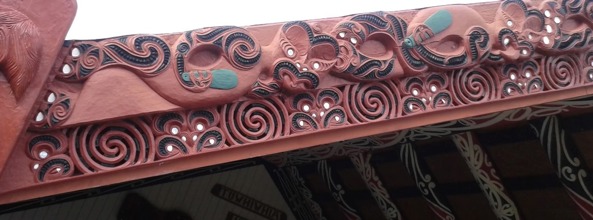Tukutuku
Te Tokotoru: ko ēnei moana kua rakaitia e ngā manukura hei tohu mō ia rohe. Ki Tauranga he pātiki nā Pauline Borell ō Pirirakau, ki Rotorua he poutama nā Tina Wirihana ō Ngāti Te Rangiunuora, ki Whakatāne he roimata toroa nā Mere Walker ō Te Whakatōhea. Ko rātau ngā manukura mō ia tira rāranga.
The Trinity: These decorative panels were created by the craftsmen to typify each area of our region.
Image description (top to bottom): For Tauranga area it is the flounder (pātiki) by Pauline Borell of Pirirakau, for Rotorua area it is the eternal stairway of knowledge (poutama) by Tina Wirihana of Ngāti Te Rangiunuora and for Whakatāne area it is albatross tears (roimata toroa) by Mere Walker of Te Whakatōhea (Ōpōtiki). They were the leaders (manukura) of each weaving team.
Te Tokotoru tukutuku panel also has a place of importance at the Council and is located at our Whakatāne office.
Te Pare Honohono a Toi-te-Huatahi
Ko te ingoa Māori mō tēnei rohe ko te Moana a Toi-te-Huatahi, nō muri iho a Kapene Kuki, nana te whakahua ko te 'Bay of Plenty'. Ko tēnei pare, ko Te Pare Honohono a Toi-te-Huatahi.
Ko Toi hoki tērā e hāpai rā i ngā taonga ō te Taiao e kore ai e pau poka noa. Koia nei hoki te kaupapa pūtake a te kaunihera. Nā reira, ko Toi tera e honohono nei i ēnei tikanga, mai i te ao tawhito ā te Māori, ki naiānei ki te ao hou ā te Kaunihera. Ko Te Hau Tutua o Ngāti Awa te tohunga whakairo.
The Māori name for this region is the Ocean of Toi-te-Huatahi. Captain Cook then named the region the Bay of Plenty. The door lintel, located above the entry to the Regional Council's Committee Room, is called Te Pare Honohono a Toi-te-Huatahi, which means the lintel of linkage with Toi-te-Huatahi. It depicts Toi as steward of our environmental resources, ensuring they will not be squandered. This accords with the Bay of Plenty Regional Council's mission statement. Toi is effectively linking the ancient Māori world with the present world. Te Hau Tutua of Ngāti Awa was the master carver who created this work.






